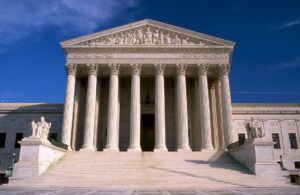01 Dec SCOTUS COVID Decision Regarding NY Restrictions for Religious Entities
 The day before Thanksgiving, the Supreme Court issued a per curiam (unsigned) 5-4 opinion enjoining New York from imposing its 10 and 25-person occupancy limits on religious institutions. Specifically, New York imposed restrictions on attendance at religious services in areas classified as “red” or “orange” zones in the State. In red zones, no more than 10 persons may attend each religious service, and in orange zones, attendance is capped at 25. Religious entities in the state challenged the order claiming it violated their First Amendment Free Exercise rights because it treated in person gatherings at religious services less favorably than comparable secular activities. For example, acupuncture facilities, camp grounds, garages, plants manufacturing chemicals and microelectronics and all transportation facilities are all exempt from the 10 and 25 person caps even if they are in a red or orange zone.
The day before Thanksgiving, the Supreme Court issued a per curiam (unsigned) 5-4 opinion enjoining New York from imposing its 10 and 25-person occupancy limits on religious institutions. Specifically, New York imposed restrictions on attendance at religious services in areas classified as “red” or “orange” zones in the State. In red zones, no more than 10 persons may attend each religious service, and in orange zones, attendance is capped at 25. Religious entities in the state challenged the order claiming it violated their First Amendment Free Exercise rights because it treated in person gatherings at religious services less favorably than comparable secular activities. For example, acupuncture facilities, camp grounds, garages, plants manufacturing chemicals and microelectronics and all transportation facilities are all exempt from the 10 and 25 person caps even if they are in a red or orange zone.
The Supreme Court agreed with the challengers and issued a preliminary injunction in the case, pending appeal. The majority opinion explained that while “[s]temming the spread of COVID-19 is unquestionably a compelling governmental interest”, New York’s restrictions were too restrictive and not narrowly tailored. The majority noted:
Members of this Court are not public health experts, and we should respect the judgment of those with special expertise and responsibility in this area. But even in a pandemic, the Constitution cannot be put away and forgotten. The restrictions at issue here, by effectively barring many from attending religious services, strike at the very heart of the First Amendment’s guarantee of religious liberty. Before allowing this to occur, we have a duty to conduct a examination of the need for such a drastic measure.
The majority rejected the dissenting opinions’ arguments that the case was moot. At the time the Court issued its opinion, the 10 and 25-person caps no longer applied and instead the churches and synagogues challenging the order could hold services at 50% occupancy. The majority explained that the case was not moot because the Governor regularly changes classifications and so the religious institutions could once again be subject to the 10 and 25 person caps.
Justice Gorsuch, in his concurrence, wrote critically of Jacobson v. Massachusetts, noting the case “hardly supports cutting the Constitution loose during a pandemic” particularly with regard to Free Exercise challenges which were not at play in Jacobson. He also sends critical barbs at his colleagues for wanting to “stay out of the way in times of crisis”, explaining the Court cannot “shelter in place when the Constitution is under attack.”
Justice Kavanaugh wrote a concurrence taking a more measured tone, explaining the New York case was distinguishable from the Court’s earlier decisions in South Bay United Pentecostal Church v. Newsom, 590 U. S. ___ (2020), and Calvary Chapel Dayton Valley v. Sisolak, 591 U. S. ___ (2020) because New York’s restrictions were much more severe. Justice Kavanaugh also explains in his view
the COVID–19 pandemic remains extraordinarily serious and deadly. And at least until vaccines are readily available, the situation may get worse in many parts of the United States. The Constitution “principally entrusts the safety and the health of the people to the politically accountable officials of the States.” South Bay, 590 U. S., at ___ (ROBERTS, C. J., concurring in denial of application for injunctive relief ) (slip op., at 2) (internal quotation marks and alteration omitted). Federal courts therefore must afford substantial deference to state and local authorities about how best to balance competing policy considerations during the pandemic. See ibid. But judicial deference in an emergency or a crisis does not mean wholesale judicial abdication, especially when important questions of religious discrimination, racial discrimination, free speech, or the like are raised.
Chief Justice Roberts dissented and would not have granted the injunction, viewing the case as moot, though he did note that he viewed the restrictions as distinguishable (and more severe) than those in which the Court had previously denied injunctions in the South Bay and Cavalry Chapel Dayton Valley cases. Justice Breyer also dissented and was joined by Justices Sotomayor and Kagan and Justice Sotomayor penned a separate dissent, which Justice Kagan joined.
To review all the decisions involved in the case, click here.




